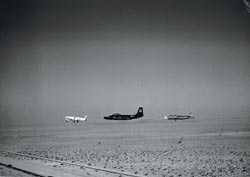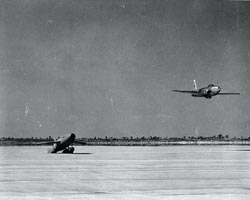|
|||||||
|
The TV-1 pilot position was known as CHARLIE. During initial flight testing the TV-1 could serve as either a missile surrogate or a backup control aircraft by simply switching control panels prior to flight. In the surrogate mode the CHARLIE pilot was basically along for the ride, the ABLE pilot in the TV-2D controlled the TV-1 in which the CHARLIE pilot was passenger.
On 22 November 1950, 36 months and 5 days after the first BuAer Letter of Intent for Project Regulus was issued and after extensive preflight checks, the chase planes took off at 0800. Minutes later, when the chase planes were three-quarters of a mile behind the missile, it was released for takeoff. FTV-1 headed straight down the runway. At 120 knots, 8 degrees up pitch was commanded and the missile responded immediately. TV-2D was flying 10 feet above the lakebed and close in on the missile’s left wing. At 190 knots the missile became airborne. After a few minor corrective maneuvers it became obvious that the missile might easily outrun the chase planes. ABLE commanded a slight increase in pitch whereupon the missile began an uncommanded bank to the right and control was lost. The missile began a series of roll oscillations, completed two rolls, passed under the TV-2D, missing it by only 10-15 feet. Seconds later FTV-1 slammed into the lakebed directly off the end of the main runway at a speed of 220 knots from an altitude of about 3500 feet. One observer was surprised at how small a dent it made on the lakebed surface. Subsequent investigations revealed that a hollow brass pin in a hydraulic motor-pump assembly had failed from fatigue. Solid steel pins were used as replacements and no further flight failures were caused by this combination of events. Extensive reliability runs were initiated to “flight qualify” each missile. This would ensure that not only would the missile be ready but ground crews would become thoroughly familiar with all the flight systems. More Regulus I: General Characteristics for an Interim Guided Missile
|

 Flight tests were conducted with two airborne aircraft, a TV-2D and a TV-1. The cockpit positions in the two-seat TV-2D director aircraft were referred to as ABLE and BAKER. ABLE position was the front cockpit where the radio command control panel was located. While the ABLE pilot would use occasional eye contact to observe the missile or drone control surfaces during maneuvers, he primarily kept his vision straight ahead. The BAKER pilot flew the TV-2D airplane in tight formation with whatever maneuvers the missile executed through the command control executed by ABLE. Thus the perception of the ABLE pilot was as if he were in the missile since his commands were immediately reflected by changes in the flight path of the TV-2D as it followed the missile. The ABLE pilot was trained to not watch the missile too long or too often.
Flight tests were conducted with two airborne aircraft, a TV-2D and a TV-1. The cockpit positions in the two-seat TV-2D director aircraft were referred to as ABLE and BAKER. ABLE position was the front cockpit where the radio command control panel was located. While the ABLE pilot would use occasional eye contact to observe the missile or drone control surfaces during maneuvers, he primarily kept his vision straight ahead. The BAKER pilot flew the TV-2D airplane in tight formation with whatever maneuvers the missile executed through the command control executed by ABLE. Thus the perception of the ABLE pilot was as if he were in the missile since his commands were immediately reflected by changes in the flight path of the TV-2D as it followed the missile. The ABLE pilot was trained to not watch the missile too long or too often.
 Two ground-based operators, known as FOX-1 and FOX-2, were also used. FOX-1 did prelaunch checkout of the missile to ensure proper control surface response. FOX-2 was at the end of the runway to control the missile during its initial takeoff roll and then turned control over to the ABLE pilot as the TV-2D swooped down for a control pickup.
Two ground-based operators, known as FOX-1 and FOX-2, were also used. FOX-1 did prelaunch checkout of the missile to ensure proper control surface response. FOX-2 was at the end of the runway to control the missile during its initial takeoff roll and then turned control over to the ABLE pilot as the TV-2D swooped down for a control pickup.